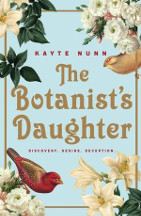The Botanist's Daughter by Kayte Nunn

Hachette, 2018. ISBN 9780733639388
(Age: Senior secondary - Adult) Starting a little slowly, yet
creating two worlds that have no defining link, this novel is
captivating, rich in depiction of the past, and cleverly
interspersing the two stories. The title suggests a story of a
family and an interest in botany, and it is that, yet this book
offers much more than a simple family history. One story is set
firmly in the present, where a young woman can take herself off to
England to seek an understanding of the book's provenance, while the
other plunges us into the past, particularly referring to the place
of women at the time of the story, telling a story set in the 1880s.
Both narratives delve into the lives of women in their era,
especially elucidating the differences between the possibilities for
the two: between education, freedom to travel, learn, work or
interact outside the family, and to create a life for one's self.
Placing her narrative in these two distinct eras, beginning the
story in the 1886, in England, and Sydney in 2017, Kayte Nunn takes
us into the lives, and indeed the minds, of two characters,
exploring their worlds and considering the wider world and time in
which each lived. Each story is lightly told while both are
revelatory of the particular differences for women in their times.
The modern story begins when an old book of beautiful botanical
illustration is discovered hidden within the wall cavity of an old
Sydney house, the owner, a young woman, is stunned. Captivated by
the beauty and artistry of the illustrations, the owner, Anna,
realizes that she is keen to unravel the mystery of the origin of
this book, and her determination to do so takes her to England. Back
in Australia, while Anna is redecorating the house, relishing her
discoveries and enjoying the search for what kind of person was this
ancestor of hers, she comes to believe that perhaps it was an
inherited interest that drew her into botany and the kind of life
had she has lived.
The story is told in two parts, that of the historical search by an
English woman and her servant, and that of the modern woman who has
found the intriguing diary. Moving back and forth between the
narratives, Nunn reveals that the original botanist was Anna's
grandmother, yet we are eager to unravel the mystery of why the book
was hidden and what is the accompanying history of this grandmother.
Beautifully written, clearly and simply narrated from the
perspective of both grandmother and granddaughter, who had not known
one another, this captivating novel creates a link between two
distinct eras. Nunn deftly creates an enigmatic story-line, while
subtly revealing the differences in the freedom and choices of women
in the modern era and that of the past in England in 1886, and
indeed of the violence that took place in defence of what one
believed to be the right to ownership.
This book is intriguing and would be appropriate for older
adolescent readers and indeed most interesting for adult readers,
particularly those who love a good historical novel that has an
added twist.
Elizabeth Bondar